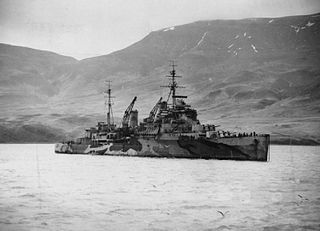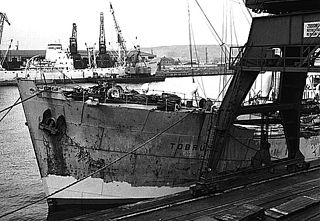Empire Elgar was a 2,847 GRT heavy lift ship that was built in 1942 by William Gray & Co Ltd, West Hartlepool, Co Durham, United Kingdom for the Ministry of War Transport (MoWT). During World War II, she served with the Arctic Convoys. In 1947, she was sold into merchant service and renamed Sea Minstrel. A further sale in 1951 saw her renamed Marandellas. In 1956, she was sold to a Norwegian company and renamed Edward Jansen. A further sale in 1960 saw her renamed Slitan. In 1961, she was sold to a Bulgarian company and renamed Pirin. She served until 1965 when she was scrapped at Split, Yugoslavia.

PQ 13 was a British Arctic convoy that delivered war supplies from the Western Allies to the USSR during World War II. The convoy was subject to attack by German air, U-boat and surface forces and suffered the loss of five ships, plus one escort vessel. Fifteen ships arrived safely.

HMS Britomart was a Halcyon-class minesweeper of the Royal Navy. She served during the Second World War and was sunk in 1944 in a friendly fire incident. The actor Robert Newton served aboard her until 1943.

HMS Mahratta was an M-class destroyer of the Royal Navy which served during World War II. Begun as Marksman, she was damaged while under construction, and dismantled to be rebuilt on a new slipway. She was launched as Mahratta in 1942, completed in 1943, and quickly pressed into service. After a short but busy career in the North Atlantic and Arctic, largely guarding merchant convoys, she was torpedoed and sunk on 25 February 1944.
Empire Archer was a 7,031 ton cargo ship which was built in 1942. She was renamed Baron Murray in 1946. In 1959 she was renamed Cathay, serving until 1963 when she was scrapped.
Empire Bard was a 3,114 GRT heavy lift ship which was built in 1941 for the Ministry of War Transport (MoWT). She was sold in 1946 and renamed Angusburn and sold again in 1955 and renamed Brettenham. After a career lasting 29 years she was scrapped in 1971.

SS West Gotomska was a steel–hulled cargo ship built in 1918 as part of the World War I emergency wartime shipbuilding program organized by the United States Shipping Board.
Empire Beaumont was a British 7,044 GRT cargo ship which was built by Furness Shipbuilding Ltd, Haverton Hill-on-Tees in 1942. She was owned by the Ministry of War Transport (MoWT) and managed by W Runciman & Co Ltd. Empire Beaumont had a short career, being sunk on 13 September 1942 while a member of Convoy PQ 18.
Norhauk was a 6,086 GRT refrigerated cargo ship which was built to Design 1015 by G. M. Standifer Construction Company, Vancouver, Washington in 1919 as Waban for the United States Shipping Board (USSB). After service with Lykes Brothers-Ripley Steamship Co Inc she was transferred to the Ministry of Shipping in 1940 and renamed Empire Sambar. A boiler-room explosion damaged her in 1941. After repairs she was renamed Empire Beaver. She was transferred to the Norwegian Government in 1942 and renamed Norhauk, serving until she struck a mine and sank in December 1943.

Tobruk was a 7,090 GRT cargo ship which was built in 1941 as Empire Builder by William Gray & Company Ltd for the Ministry of War Transport (MoWT). On completion she was handed over to the Polish government-in-exile and renamed Tobruk. She was a member of a number of convoys during the Second World War. She was sold in 1951 to Polskie Linie Oceaniczne and served until 1967. She was scrapped in 1968.
Empire Byron was a 6,645 GRT cargo ship which was built in 1941 for the Ministry of War Transport (MoWT). Completed in January 1942, she had a short service career. Empire Byron was torpedoed and sunk on 5 July 1942 by German submarine U-703 while a member of Convoy PQ 17.
Empire Carpenter was a 7,025 GRT cargo ship which was built in 1942 for the Ministry of War Transport (MoWT). In 1944 she was leased to the Soviet Union and renamed Dickson. In 1946, she was returned to the United Kingdom and regained her former name of Empire Carpenter. She was sold in 1947 and renamed Petfrano. In 1955, she was sold to Panama owners and renamed Amipa, further sales saw her renamed Apex. In 1968, she was sold to Cypriot owners and renamed Afros, serving until scrapped in 1971.
Empire Clarion was a 7,031 GRT cargo ship which was built in 1942 by William Gray & Co. Ltd., West Hartlepool for the Ministry of War Transport (MoWT). In 1946 she was sold and renamed Cedarpool. She served until 1959, when she was scrapped.

SS Empire Celia was a 7,025 GRT cargo ship built in 1943 by Charles Connell and Company Ltd of Scotstoun, Glasgow for the Ministry of War Transport (MoWT). In 1948 she was sold into merchant service and renamed Putney Hill. Further name changes were Castle Hill in 1949 and London Statesman in 1950. In 1951 she was sold to Panamanian owners and renamed Morella, being sold later that year to Polskie Linie Oceaniczne and renamed Jedność. She served until 1966, when she was scrapped.
Convoy JW 51A was an Arctic convoy sent from Great Britain by the Western Allies to aid the Soviet Union during World War II. It sailed in December 1942, reaching the Soviet northern ports at the end of the month.
Empire Cowper was a 7,161 GRT cargo ship that was built in 1941 by William Doxford & Sons Ltd, Sunderland, United Kingdom. She was built for the Ministry of War Transport. Empire Cowper was bombed and sunk on 11 April 1942 whilst a member of Convoy QP 10.
Norlom was a 6,326 GRT Design 1105 cargo ship that was built in 1919 as Editor by Skinner & Eddy Corporation, Seattle, Washington, United States for the United States Shipping Board (USSB), which became the United States Maritime Commission (USMC) in 1937. In 1941, she was transferred to the British Ministry of War Transport (MoWT) and renamed Empire Dunlin. She was transferred to Norway in 1942 and renamed Norlom. She served until 2 December 1943 when she was bombed and sunk at Bari, Italy.
Celia was a Shakespearian-class naval trawler, launched in late 1940. She served through World War II as a minesweeper and was sold in 1946.
Empire Emerald was a 8,032 GRT tanker that was built in 1941 by Furness Shipbuilding Co Ltd, Haverton Hill-on-Tees, Co Durham, United Kingdom for the Ministry of War Transport (MoWT). She was sold into merchant service in 1946 and renamed El Gallo, serving until 1959 when she was scrapped.

HMS Dianella was a Flower-class corvette of the Royal Navy. She served during the Second World War.







